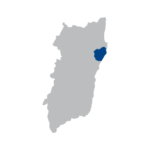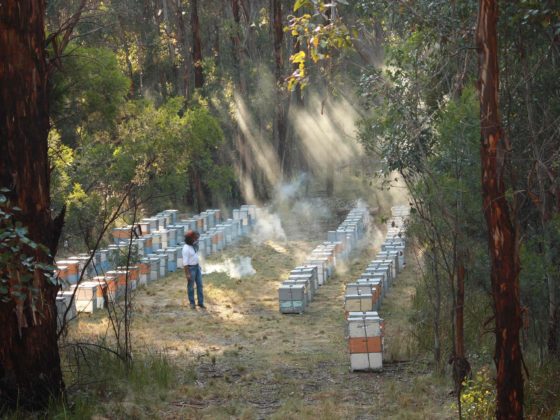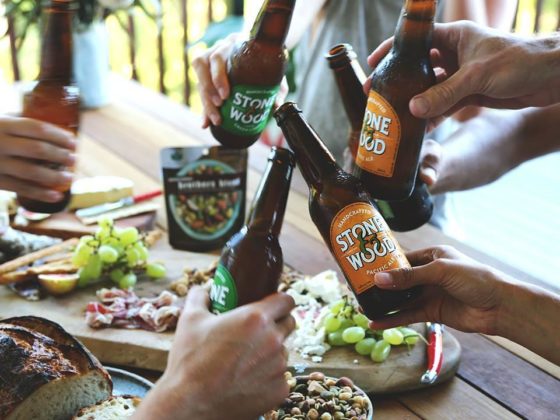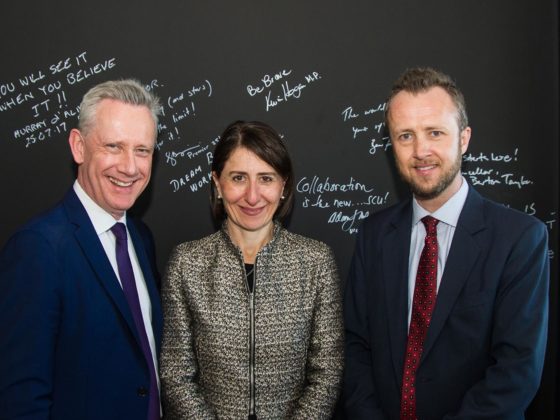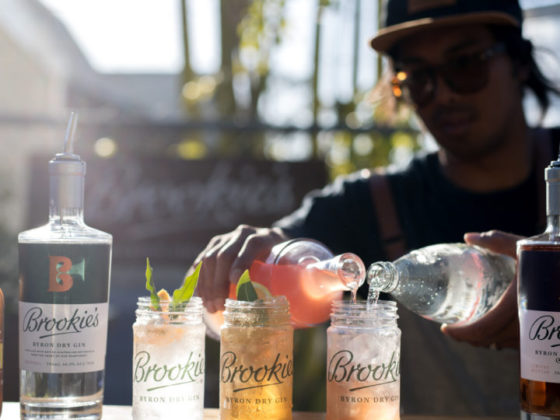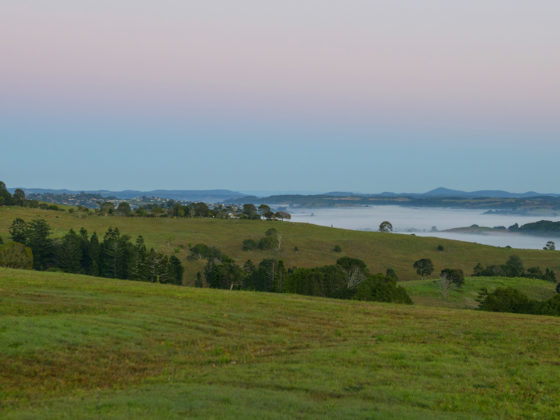an epic adventure into healing honey
Gather By is a closed-loop regenerative agribusiness that works with beekeepers and landholders in NSW and Queensland, and investors around Australia to produce and market rare, pure and potent Australian Manuka honey.
The business, with its headquarters near Ballina/Byron Gateway Airport, is reinvigorating Australia’s honey industry and is exporting 90% of its products to meet strong global demand for medicinal and therapeutic qualities of Manuka, used for everything from healing infections, burns and wounds, to soothing sore throats, and boosting gut health and immunity.
The work that has gone in over the past nine years to get to this point is a cross between Indiana Jones and David Attenborough.
The story of research and development begins in 2011 with Gather By founder and chief executive, Matt Blomfield, returning from New York where he’d been leading an information security business. He took some time out to quietly renovate an old boat near Sydney. “I went into deep introspection of all my life experiences and from that I decided to look into our food security here in Australia and what was going on,” Matt says.
“Food supply in the hands of corporations with large monoculture plantings is not good for us humans, our habitat, or our native flora and fauna. The onset of climate volatility is putting considerable pressure on our food security.”
As he was pondering how to put his experience, skills and resources towards his food security initiative, he was fortuitously had a work visit to New Zealand and discovered that Manuka beekeepers there earn $10 to $50 per kilo of honey using one Australian indigenous plant variety, Leptospermum scoparium, and from that, New Zealanders have built a $600 million industry.
When Matt researched the Australian beekeeping industry he found that Australia has 87 varieties of Leptospermum, also known as Manuka or Jelly Bush. Despite this, many beekeepers were struggling to earn a living, often receiving only $5 a kilo (or less) for their honey, and most were aged well into their 60s and 70s. This was happening as the Australian market was becoming saturated by tonnes of cheap honey imported by multinational corporates to sell to Australians, often with misleading labelling. The future of the honey industry looked dire, but from that there was opportunity.
“By joining the dots of all my life experiences, and acting on this opportunity, I invested my life savings into this food security initiative: to build healthy honeybee colonies by growing Australian native bushes to produce a high-value medicinal and therapeutic honey. I assembled a team and with purpose, passion and persistence we have made Gather By what it is now,” Matt says.
With dots joined, Matt brought a small team of specialists and an angel investor and went on an epic journey through remote Australian bushland in search of the remaining stands of Leptospermum. It took five years – many years longer than any of them expected. It involved tough physical conditions with Matt and two other researchers sitting deep in the bush in 30 to 40c subtropical heat, testing thousands and thousands of plants for their antibacterial and antibiotic strength, making detailed notes, geocoding plant locations, and sending cuttings to specialised plant propagation nurseries.
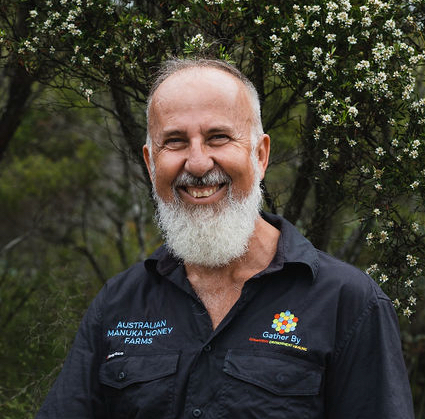

The team collaborated with University of the Sunshine Coast and University of Western Australia to identify the valuable molecule in the nectar of these plants, Dihydroxyacetone (or DHA) “Some of the varieties we found were 10 times higher in DHA than the New Zealand plants.” And the higher the DHA in the nectar, the higher the methylglyoxal (MGO) in the honey (which is compound responsible for strong antibacterial properties), the higher the value of the honey, the higher return to the grower or landholder.
The next steps weren’t straightforward even after finally locating and identifying multiple varieties of highly-active Leptospermum sources.
“The first plantings had multiple fails with 80 to 90% of the plants dying,” Matt says. This took more trial and error, more time, and more funds (with small private financial backing boosted by small government grants and collaboration with universities along the way).
“In subsequent plantings, by varying multiple parameters, we got through it and we had a planting model that worked with more than 90% of the plants surviving.”
This biodiverse planting model was named the ‘Medicinal Honey Forest (MHF)’ which included multiple varieties of Leptospermum plus bee fodder plants, designed to keep the bees ‘in situ’, healthy and strong, and to bring back our native fauna.
“It is a new way of beekeeping and honey farming: bring food to the bees and not truck bees to the food.”
Gather By now works with growers and landholders to grow these special plants and produce nectar. After a few years, honeybees are brought on by Gather By or local beekeepers to extract the honey. The honey is then stored for up to 12 months at temperatures to mature its strength, in Ballina in a new, controlled process to preserve all the honey’s beneficial enzymes.
The Manuka honey that Gather By collects and sells has superior potent quantities of MGO packed in jars with levels of 100, 250, 500, 800 and 1000 MGO. Higher MGO honey has stronger medicinal and therapeutic benefits, with lower being consumed for taste, general health and wellness.
“We set out as food security initiative and to do this ended up producing and exporting this world-premium medicinal and therapeutic honey while bringing diversification options to landholders and First Nation’s People, creating projects and jobs,” Matt says.
“This new closed-loop regenerative agribusiness is attracting younger beekeepers by bringing incremental income to regional communities with projects and jobs that have value, with MHF owners sometimes being paid more than $100 per kilo for ultra-high MGO honey”
Matt says the global market for high MGO honey is relatively new, with strong demand that is growing alongside interest in natural and complementary medicines. Now that all the development work has been done, and with multiple propagation nurseries in biosecure locations, and thousands of hectares under license grouped into MHF – the business is focused on growth.
Matt’s 10-year plan for Gather By is to create a half billion-dollar industry along the east coast of Australia, that will produce around 2000 tonnes of honey and employ hundreds of people directly and indirectly in the industry.
“Three years into that 10-year plan and we’re on track,” Matt says.
May it be a sweet and potent success.
“I decided to look into our food security here in Australia and what was going on”
Share this story
Read more stories
let there be light
https://ingoodcompanynorthernrivers.com.au/wp-content/uploads/2018/04/northern_lights-_ballina_northern_rivers_001.jpg 2000 1333 In Good Company | Northern Rivers In Good Company | Northern Rivers https://ingoodcompanynorthernrivers.com.au/wp-content/uploads/2018/04/northern_lights-_ballina_northern_rivers_001.jpgNorthern Light
“I eat a pot of honey every day and I’ve been stung more than 70,000 times,” says Jeffrey Gibbs, founder of Northern Light, an organic beeswax…
not just a business, a community partner
https://ingoodcompanynorthernrivers.com.au/wp-content/uploads/2018/04/stone-and-wood-001.jpg 960 761 In Good Company | Northern Rivers In Good Company | Northern Rivers https://ingoodcompanynorthernrivers.com.au/wp-content/uploads/2018/04/stone-and-wood-001.jpgStone & Wood
“That’s like asking parents to name which of their children they prefer,” says Jamie Cook, Stone & Wood co-founder. He has been asked which of the…
a natural business adventure
https://ingoodcompanynorthernrivers.com.au/wp-content/uploads/2018/04/Mount-Warning-Tours-01.jpg 1920 1080 In Good Company | Northern Rivers In Good Company | Northern Rivers https://ingoodcompanynorthernrivers.com.au/wp-content/uploads/2018/04/Mount-Warning-Tours-01.jpgMount Warning Tours
Despite only existing for four years, Mount Warning Tours’ short life has been eventful: from purchasing the ex-Murray River ferry Spirit of Wollumbin…
partners with industry, partners with community
https://ingoodcompanynorthernrivers.com.au/wp-content/uploads/2018/07/SCU-Enterprise-Lab-launch-copy.jpg 2000 1048 In Good Company | Northern Rivers In Good Company | Northern Rivers https://ingoodcompanynorthernrivers.com.au/wp-content/uploads/2018/07/SCU-Enterprise-Lab-launch-copy.jpgSouthern Cross University
Celebrating a silver anniversary is a significant milestone, 25 years of developing your relationship, exploring and accepting your strengths…
Townsend taproom breakthrough brews
https://ingoodcompanynorthernrivers.com.au/wp-content/uploads/2022/12/Sanctus-Brewing.jpg 1123 627 In Good Company | Northern Rivers In Good Company | Northern Rivers https://ingoodcompanynorthernrivers.com.au/wp-content/uploads/2022/12/Sanctus-Brewing.jpgSanctus Brewing Co.
When Sanctus Brewing Co. began life in 2019, there was no indication that the brewery would go on to enjoy the immense success it has over the last three years.
putting the business into ‘show business’
https://ingoodcompanynorthernrivers.com.au/wp-content/uploads/2022/11/Brainstorm-Productions-image2-scaled.jpg 2560 1709 In Good Company | Northern Rivers In Good Company | Northern Rivers https://ingoodcompanynorthernrivers.com.au/wp-content/uploads/2022/11/Brainstorm-Productions-image2-scaled.jpgBrainstorm Productions
You might think that COVID-19 would rattle a business that delivers educational theatre into schools. But the “show must go on” mentality runs deep for Brainstorm Productions’ founder and artistic director Jenny Johnson…
Art of Glass
https://ingoodcompanynorthernrivers.com.au/wp-content/uploads/2022/12/Tweed-Coast-Glass_product-shot.jpg 541 817 In Good Company | Northern Rivers In Good Company | Northern Rivers https://ingoodcompanynorthernrivers.com.au/wp-content/uploads/2022/12/Tweed-Coast-Glass_product-shot.jpgTweed Coast Glass
Anyone who lives between the Gold Coast and Ballina with even a passing involvement in the building trade will be familiar with Tweed Coast Glass.
revving up the community engine
https://ingoodcompanynorthernrivers.com.au/wp-content/uploads/2018/06/oatten-and-hoffman-kyogle-002.jpg 1000 667 In Good Company | Northern Rivers In Good Company | Northern Rivers https://ingoodcompanynorthernrivers.com.au/wp-content/uploads/2018/06/oatten-and-hoffman-kyogle-002.jpgOaten and Hoffman
In 2015 Tim Hoffman was riding the high on business success, and had no clue about the blow that was awaiting him….
fastest growing, remains humble and local
https://ingoodcompanynorthernrivers.com.au/wp-content/uploads/2018/06/tripadeal-byron-bay-002.jpg 1000 667 In Good Company | Northern Rivers In Good Company | Northern Rivers https://ingoodcompanynorthernrivers.com.au/wp-content/uploads/2018/06/tripadeal-byron-bay-002.jpgTripADeal
For TripADeal, the figures speak for themselves: revenue in excess of $100million for 2017; 75,000 travellers sent to various…
Farmers in the fields
https://ingoodcompanynorthernrivers.com.au/wp-content/uploads/2022/12/E0A8334.jpg 2048 1366 In Good Company | Northern Rivers In Good Company | Northern Rivers https://ingoodcompanynorthernrivers.com.au/wp-content/uploads/2022/12/E0A8334.jpgNorco Primex
Bruce Wright has made his career by bringing together and supporting many of the region’s farmers and primary producers.
following her art’s desires
https://ingoodcompanynorthernrivers.com.au/wp-content/uploads/2022/11/Bingara_Angela-Parr-scaled.jpg 2560 2198 In Good Company | Northern Rivers In Good Company | Northern Rivers https://ingoodcompanynorthernrivers.com.au/wp-content/uploads/2022/11/Bingara_Angela-Parr-scaled.jpgBingara Gallery
If she wasn’t painting wild animals and birds, artist Angela Parr, 62, would most likely be rescuing them, healing them, or advocating for them…
making history, creating culture
https://ingoodcompanynorthernrivers.com.au/wp-content/uploads/2018/04/SPAR-Staff.jpg 1535 1025 In Good Company | Northern Rivers In Good Company | Northern Rivers https://ingoodcompanynorthernrivers.com.au/wp-content/uploads/2018/04/SPAR-Staff.jpgSpar Maclean
SPAR Maclean’s claim to fame is a doozy. Indeed, it’s something only one supermarket in the whole of Australia can say: that it is the longest…
spirit of the rainforest
https://ingoodcompanynorthernrivers.com.au/wp-content/uploads/2018/04/cape-byron-distellery-002.jpg 960 540 In Good Company | Northern Rivers In Good Company | Northern Rivers https://ingoodcompanynorthernrivers.com.au/wp-content/uploads/2018/04/cape-byron-distellery-002.jpgCape Byron Distillery
Let’s forget the beaches for a moment, as the true lifeblood of the Northern Rivers landscape is surely its rainforests, some of the most botanically…
Casino RSM Club
https://ingoodcompanynorthernrivers.com.au/wp-content/uploads/2022/12/RMS-Club.jpeg 1360 906 In Good Company | Northern Rivers In Good Company | Northern Rivers https://ingoodcompanynorthernrivers.com.au/wp-content/uploads/2022/12/RMS-Club.jpegCasino RSM Club
The 23 of March 2020 was the hardest day of Neale Genge’s career.
Hovering across the wave of success
https://ingoodcompanynorthernrivers.com.au/wp-content/uploads/2022/11/FliteImage.jpg 1139 749 In Good Company | Northern Rivers In Good Company | Northern Rivers https://ingoodcompanynorthernrivers.com.au/wp-content/uploads/2022/11/FliteImage.jpgFliteboard
It was meant to be an extended break for David Trewern and his family. A chance to rest and reset in Byron Bay after decades of building and selling fast-growing digital marketing agencies. But as he looked out over Belongil beach in 2014, an idea struck him.
In Ventura we trust
https://ingoodcompanynorthernrivers.com.au/wp-content/uploads/2022/12/Ventura-Brewing_product-shot.jpg 2500 1667 In Good Company | Northern Rivers In Good Company | Northern Rivers https://ingoodcompanynorthernrivers.com.au/wp-content/uploads/2022/12/Ventura-Brewing_product-shot.jpgVentura Brewing
Ventura is a symbol of luck, chance and good fortune – and while Ventura Brewing’s two founders have had a good dose of all three – it’s mostly been a lot of hard work and focus to launch this craft kombucha brewery amid a global pandemic.
A community cornerstone bouncing forward
https://ingoodcompanynorthernrivers.com.au/wp-content/uploads/2022/12/Coraki-Post-Office.jpeg 2048 1260 In Good Company | Northern Rivers In Good Company | Northern Rivers https://ingoodcompanynorthernrivers.com.au/wp-content/uploads/2022/12/Coraki-Post-Office.jpegCoraki Post Office
For all that has been thrown at the small town of Coraki in recent times, the owners of the town’s post office are rolling with the punches.
A walk on the wild side
https://ingoodcompanynorthernrivers.com.au/wp-content/uploads/2022/11/Fix-Vision-Walks.jpg 1245 933 In Good Company | Northern Rivers In Good Company | Northern Rivers https://ingoodcompanynorthernrivers.com.au/wp-content/uploads/2022/11/Fix-Vision-Walks.jpgVision Walks Eco Tours
Wendy Bithell has built her multi-award-winning eco-tourism business, Vision Walks – Eco Tours, by combining her two areas of expertise: ecology and technology. Her Byron hinterland adventures are as diverse as nature walks with night vision goggles, Indigenous bush tucker tours, and three-day women’s indulgence escapes.
in for the long haul
https://ingoodcompanynorthernrivers.com.au/wp-content/uploads/2018/04/7D2_1365.jpg 1024 682 In Good Company | Northern Rivers In Good Company | Northern Rivers https://ingoodcompanynorthernrivers.com.au/wp-content/uploads/2018/04/7D2_1365.jpgHerb Blanchard Haulage
If you happen to be in the ‘jacaranda city’ of Grafton or its surrounds and you see a big blue truck out on the roads, the chances are its part of the…
home is where the heart is
https://ingoodcompanynorthernrivers.com.au/wp-content/uploads/2018/04/edmonds-conveyancing-ballina-001.jpg 1920 847 In Good Company | Northern Rivers In Good Company | Northern Rivers https://ingoodcompanynorthernrivers.com.au/wp-content/uploads/2018/04/edmonds-conveyancing-ballina-001.jpgEdmonds Conveyancing
The legal aspects of buying and selling a property are not normally associated with having a laugh and even singing, but the Edmonds Conveyancing…



